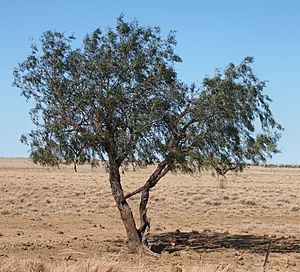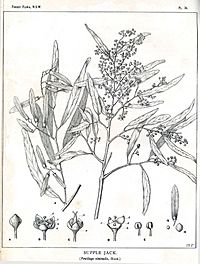Supplejack facts for kids
Quick facts for kids Supplejack |
|
|---|---|
 |
|
| Scientific classification | |
| Genus: |
Ventilago
|
| Species: |
viminalis
|
The Supplejack (Ventilago viminalis) is a unique plant found in Australia. It's also known as the vine tree or whip vine. This plant grows across a large part of Northern and Central Australia. You can find it from the sunny coasts of Queensland all the way to the Northern Territory and Western Australia. It even pops up sometimes in New South Wales and South Australia.
Contents
What Supplejack Looks Like
When the supplejack plant is young, it's a bit like a climber. It uses other trees, bushes, and even grasses to help it grow upwards. As it gets older, its stem becomes more woody. Eventually, it starts to look more like a typical tree.
This tree can grow up to 7 metres (about 23 feet) tall. It often has several main trunks. Its branches tend to hang down, giving it a droopy look. The bark is dark and has many cracks or fissures.
The leaves of the supplejack are green and shaped like a spear. They have small stalks that connect them to the branch. Its flowers are small and have a greenish-yellow color. The time when the plant flowers can change depending on how much rain there has been. The fruits are special because they don't split open. Each fruit has one long, noticeable wing, which helps it to spread its seeds.
How Supplejack Got Its Name
The supplejack was first officially described in 1848 by a scientist named William Jackson Hooker. The second part of its scientific name, viminalis, is a Latin word. It means that the plant has long, flexible shoots. These shoots were historically good for making things like baskets.
This plant belongs to the Rhamnaceae family. This is a group of plants often called the buckthorn family.
Supplejack: A Plant of Many Uses
For many years, Indigenous Australians have used the supplejack plant in different ways.
Food and Medicine
One interesting use is eating the gum from the tree. People scrape the gum off as it comes out of the bark. They twist it onto a stick and can chew it, much like modern chewing gum. In the Arrernte language, the supplejack is called Atnyerampwe. The gum itself is known as Ngwarle atnyerampwe.
In the Kimberley region, people often call Ventilago viminalis the 'medicine tree'. Local people cut pieces from the bark or roots. They then boil these pieces to make a special liquid. This liquid is used to help treat different skin problems. It can also be used for bruises and aches in joints or muscles. You can often spot these trees in the bush because they have large, oval or oblong scars on their bark. These marks show where pieces were cut out.
Tools and Shelter
The Walmajarri people, who live near Paruku, also use the supplejack wood. They use it to make clapsticks, which are musical instruments. They also craft shields and fighting sticks from the wood. It's also a good source of firewood. Besides all these uses, the supplejack is known as a good shade tree. Its Walmajarri name is Walakarri.



